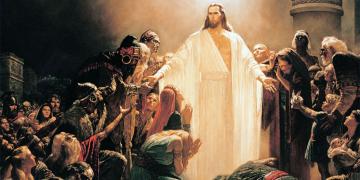You are here
Book of Mormon Central is in the process of migrating to our new Scripture Central website.
We ask for your patience during this transition. Over the coming weeks, all pages of bookofmormoncentral.org will be redirected to their corresponding page on scripturecentral.org, resulting in minimal disruption.
In the Sermon on the Mount, beloved by Christians all around the world, the Savior commanded his disciples: “Be ye therefore perfect, even as your Father which is in heaven is perfect” (Matthew 5:48). Such a lofty goal not only feels out of reach for many, but it can also be demoralizing for all who are imperfectly striving to live a Christ-like life. As Elder Jeffrey R. Holland put it in the 2017 October General Conference, “With that concluding imperative, we want to go back to bed and pull the covers over our head. Such celestial goals seem beyond our reach. Yet surely,” Elder Holland continued, “the Lord would never give us a commandment He knew we could not keep.”
Elder Holland went on to say, “I believe that Jesus did not intend His sermon on this subject to be a verbal hammer for battering us about our shortcomings.” Instead, Elder Holland stressed:
As children of God, we should not demean or vilify ourselves, as if beating up on ourselves is somehow going to make us the person God wants us to become. No! With a willingness to repent and a desire for increased righteousness always in our hearts, I would hope we could pursue personal improvement in a way that doesn’t include getting ulcers or anorexia, feeling depressed or demolishing our self-esteem. That is not what the Lord wants for Primary children or anyone else who honestly sings, “I’m trying to be like Jesus.”
How, then, can Latter-day Saints and Christian disciples everywhere pursue the perfection Christ has asked of us all, despite our short comings? Important differences in how the Resurrected Lord presented this same command to the Nephites in 3 Nephi provides clues that can help us answer this question.
First, in the New Testament the Savior “went up into a mountain” (Matthew 5:1) to give this discourse, a setting that symbolically hints at a connection to the temple. In the Book of Mormon, however, the Savior’s similar discourse is deliberately given right at the temple, making the temple context of the discourse perfectly clear. In both ancient and modern times, the primary function of temples is to serve as places for worshippers to make covenants with God. Thus, as John W. Welch has pointed out, this and other details place this discourse in a covenant-making context.1
Second, there is an important difference in how the Resurrected Lord expressed the command to be perfect to his New World disciples: “Therefore I would that ye should be perfect even as I, or your Father who is in heaven is perfect” (3 Nephi 12:48). By including Himself in the command, Jesus indicted that he was now perfect in a way that he was not before, and that it was the same way the Father was perfect, and that it was the same kind of perfection expected of all Christian disciples.
These facts add many rich levels of meaning to the commission to be “perfect” as issued by the Savior.2 One such level of meaning is that of the covenant path. In his recent book, The Covenant Path in the Bible and the Book of Mormon, Latter-day Saint scholar Taylor Halverson pointed out when covenanting with Abraham, the Lord appear to him and said, “I am the Almighty God; walk before me, and be thou perfect” (Genesis 17:1). “In the covenantal context,” Halverson explained, “‘perfect’ is a synonym to faithfulness, loyalty, and trustworthiness.”3 The Lord wanted Abraham to be loyal and faithful to Him.
If the Sermon on the Mount is then considered in the covenant-making context of the temple, then the commission “to be perfect” here is the same as that issued to Abraham: it is the call to be loyal and faithful to the new covenant established by Jesus Christ. According to Halverson, “Jesus asks us to be loyal. What is the covenant that we willingly enter into to show loyalty? … The Higher Law revealed through Jesus at the Sermon on the Mount and His other revelations.”4
At Bountiful, there are a number of reasons why the resurrected and exalted Jesus could now include Himself as an exemplar of such perfection, including the fact that through His sacrificial death, He had proven Himself loyal to God. Halverson noted, “Because Jesus had fully completed the mission God sent him on, Jesus was fully and totally loyal to God. He had been perfect to the covenantal expectations” placed on Him by the Father.5
Understood this way, the commission to be “perfect” is no longer the impossible demand to live life flawlessly. It is the invitation to walk along the covenant path—to show loyalty to God and Christ by being true to the covenants made at baptism and in the temple. In return, God and Christ will also be perfectly loyal to us, allowing each person to achieve “perfection in Christ” through His Atoning grace (Moroni 10:32). As Elder Holland concluded:
Brothers and sisters, every one of us aspires to a more Christlike life than we often succeed in living. If we admit that honestly and are trying to improve, we are not hypocrites; we are human. May we refuse to let our own mortal follies, and the inevitable shortcomings of even the best men and women around us, make us cynical about the truths of the gospel, the truthfulness of the Church, our hope for our future, or the possibility of godliness. If we persevere, then somewhere in eternity our refinement will be finished and complete—which is the New Testament meaning of perfection.
- 1. See John W. Welch, Illuminating the Sermon at the Temple and the Sermon on the Mount (Provo, UT: FARMS, 1999).
- 2. See Welch, Illuminating the Sermon, 74–78.
- 3. Taylor Halverson, The Covenant Path in the Bible and the Book of Mormon (Line of Sight Publishing, 2020), 36.
- 4. Halverson, Covenant Path, 132–133.
- 5. Halverson, Covenant Path, 300.
Subscribe
Get the latest updates on Book of Mormon topics and research for free










